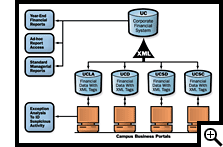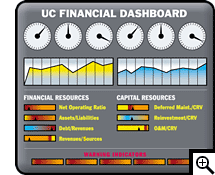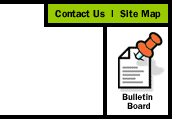The University's financial systems are robust and reliable, but do not provide the type of integration and flexible reporting demanded by the new business environment.
Data warehouses have provided a useful mechanism for departments and divisions to make accurate and current information available to those who need it across the campus and across the University. However, campuses report financial data to the Office of the President in fixed formats and on regular schedules. This limits the uses of the information.
A new Universitywide financial reporting system is needed to integrate financial data from the ten campuses and to address the following issues:
- Access: Campuses and the Office of the President are currently required to use multiple accounts and passwords to access systems that present a significant barrier to access and productivity.
- Form: Fixed reporting formats prevent ad hoc queries and easy data retrieval and reporting. Reconciliation of data sources and formats is a time consuming "non-value-added" activity today. Fiscal close lead times reflect these financial systems constraints.
- Content: Lack of flexibility restricts the content that both campuses and the Office of the President can extract from the University's financial systems. Examples include point-in-time snapshots of financial "health" indicators such as actual versus budgeted expenditures by department.
An Integrated UC-wide Financial Reporting System
UC has an opportunity to build upon its investment in campus financial systems by adding capabilities for UC-wide access to data and management information. The Planning Group recognizes that the cost of implementing a single, consolidated UC financial system would exceed the benefits derived from such an effort, particularly in light of recent cautionary reports on large-scale campus administrative systems. Referencing the difficulties many government and private sector institutions have had trying to build complex information systems (including campus administrative systems), a recent National Science Foundation report states that "$100 million failures in large scale administrative systems are all too frequent and need further attention and research." 8
Technology developments today are allowing complex organizations to address data consolidation and reporting needs without exorbitant costs. Many higher education institutions today are leveraging investments in legacy systems by building Web interfaces and data warehouses that allow students and staff to reach and add to existing data more easily.9
In a recent recommendation to the UCLA campus to make focused, incremental changes to its existing financial systems rather than implement an entire financial system replacement, KPMG advised:
"The complex 'make' or 'buy' decision can be impacted by several factors including the pace of technological change, the life-cycle status of available applications, the institution's view of financial operations, its readiness for change, the availability of financial, human and technological resources, and other issues."
The evolution of the Internet as a viable business transaction environment and the development of new technologies for data sharing and user authentication support the University's move to a New Business Architecture for financial management and reporting. The following strategies will result in integrated, up-to-date, flexible financial information that is accessible throughout the University.
 Use Data Sharing Protocols to Link All Campus Financial Systems. The first step is to provide an enhanced linkage between the campus financial systems and data warehouses and the systemwide repository of financial data. A UC Corporate Information Warehouse will receive a variety of financial data from campus financial systems. Extensible Markup Language (XML) is the protocol that makes this exchange and data transfer possible.
Use Data Sharing Protocols to Link All Campus Financial Systems. The first step is to provide an enhanced linkage between the campus financial systems and data warehouses and the systemwide repository of financial data. A UC Corporate Information Warehouse will receive a variety of financial data from campus financial systems. Extensible Markup Language (XML) is the protocol that makes this exchange and data transfer possible.
Provide All Financial Reporting and Transactions via Web-Based Applications. Today, many UC campuses have developed interfaces for their financial systems that allow users to enter and receive information on the Web. The business model of the future will be designed to take full advantage of Web capabilities to:

- Facilitate system updates to ensure that information is current and accurate
- Ensure "portability" and sharing of data
- Deliver one-stop shopping to users from different departments and organizations
- Provide easier navigation and access to information
Extensible Markup Language (XML) will also make it easier to enhance existing mainframe-based financial systems by providing Web-based interfaces to these applications via campus business portals.
Implement Flexible Tools for Financial Reporting, Projections & Modeling.
In order to make current and relevant financial information readily available to managers across the University of California, the financial information system will require a decision-support system that includes tools and models for the analysis and display of financial information. These tools must be intuitive, easy to access and use, and flexible enough to accommodate data in different formats and protocols. Above all, they must bring the data to life for managers looking to gain a better understanding of their campus or Universitywide financial operations.
Provide Web-Based Training and Instruction in the Use of Financial Systems Tools. Departmental Business Officers throughout the University require just-in-time access to training and "how-to" information about processing financial transactions in the course of every work day. Managers need financial systems to guide them through the formulation of financial reports and projections. An integrated financial information system must provide both introductory and advanced level hand-holding for its users.
Create Opportunities for Feedback on Functionality & Design. Systemwide sharing of financial information for ad hoc analysis and reporting will create a community of professionals who will have good ideas for the improvement of the financial information system. The new business model will enable these individuals to provide feedback and suggestions about needed improvements and additions to the system.




